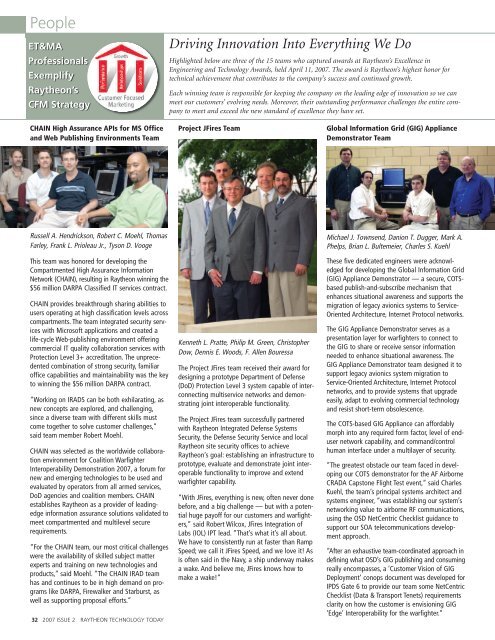2007 Issue 2 - Raytheon
2007 Issue 2 - Raytheon
2007 Issue 2 - Raytheon
You also want an ePaper? Increase the reach of your titles
YUMPU automatically turns print PDFs into web optimized ePapers that Google loves.
People<br />
ET&MA<br />
Professionals<br />
Exemplify<br />
<strong>Raytheon</strong>’s<br />
CFM Strategy<br />
CHAIN High Assurance APIs for MS Office<br />
and Web Publishing Environments Team<br />
Russell A. Hendrickson, Robert C. Moehl, Thomas<br />
Farley, Frank L. Prioleau Jr., Tyson D. Vooge<br />
This team was honored for developing the<br />
Compartmented High Assurance Information<br />
Network (CHAIN), resulting in <strong>Raytheon</strong> winning the<br />
$56 million DARPA Classified IT services contract.<br />
CHAIN provides breakthrough sharing abilities to<br />
users operating at high classification levels across<br />
compartments. The team integrated security services<br />
with Microsoft applications and created a<br />
life-cycle Web-publishing environment offering<br />
commercial IT quality collaboration services with<br />
Protection Level 3+ accreditation. The unprecedented<br />
combination of strong security, familiar<br />
office capabilities and maintainability was the key<br />
to winning the $56 million DARPA contract.<br />
“Working on IRADS can be both exhilarating, as<br />
new concepts are explored, and challenging,<br />
since a diverse team with different skills must<br />
come together to solve customer challenges,”<br />
said team member Robert Moehl.<br />
CHAIN was selected as the worldwide collaboration<br />
environment for Coalition Warfighter<br />
Interoperability Demonstration <strong>2007</strong>, a forum for<br />
new and emerging technologies to be used and<br />
evaluated by operators from all armed services,<br />
DoD agencies and coalition members. CHAIN<br />
establishes <strong>Raytheon</strong> as a provider of leadingedge<br />
information assurance solutions validated to<br />
meet compartmented and multilevel secure<br />
requirements.<br />
“For the CHAIN team, our most critical challenges<br />
were the availability of skilled subject matter<br />
experts and training on new technologies and<br />
products,” said Moehl. “The CHAIN IRAD team<br />
has and continues to be in high demand on programs<br />
like DARPA, Firewalker and Starburst, as<br />
well as supporting proposal efforts.”<br />
32 <strong>2007</strong> ISSUE 2 RAYTHEON TECHNOLOGY TODAY<br />
Driving Innovation Into Everything We Do<br />
Highlighted below are three of the 15 teams who captured awards at <strong>Raytheon</strong>’s Excellence in<br />
Engineering and Technology Awards, held April 11, <strong>2007</strong>. The award is <strong>Raytheon</strong>’s highest honor for<br />
technical achievement that contributes to the company’s success and continued growth.<br />
Each winning team is responsible for keeping the company on the leading edge of innovation so we can<br />
meet our customers’ evolving needs. Moreover, their outstanding performance challenges the entire company<br />
to meet and exceed the new standard of excellence they have set.<br />
Project JFires Team<br />
Kenneth L. Pratte, Philip M. Green, Christopher<br />
Dow, Dennis E. Woods, F. Allen Bouressa<br />
The Project JFires team received their award for<br />
designing a prototype Department of Defense<br />
(DoD) Protection Level 3 system capable of interconnecting<br />
multiservice networks and demonstrating<br />
joint interoperable functionality.<br />
The Project JFires team successfully partnered<br />
with <strong>Raytheon</strong> Integrated Defense Systems<br />
Security, the Defense Security Service and local<br />
<strong>Raytheon</strong> site security offices to achieve<br />
<strong>Raytheon</strong>’s goal: establishing an infrastructure to<br />
prototype, evaluate and demonstrate joint interoperable<br />
functionality to improve and extend<br />
warfighter capability.<br />
“With JFires, everything is new, often never done<br />
before, and a big challenge — but with a potential<br />
huge payoff for our customers and warfighters,”<br />
said Robert Wilcox, JFires Integration of<br />
Labs (IOL) IPT lead. “That’s what it’s all about.<br />
We have to consistently run at faster than Ramp<br />
Speed; we call it JFires Speed, and we love it! As<br />
is often said in the Navy, a ship underway makes<br />
a wake. And believe me, JFires knows how to<br />
make a wake!”<br />
Global Information Grid (GIG) Appliance<br />
Demonstrator Team<br />
Michael J. Townsend, Danion T. Dugger, Mark A.<br />
Phelps, Brian L. Bultemeier, Charles S. Kuehl<br />
These five dedicated engineers were acknowledged<br />
for developing the Global Information Grid<br />
(GIG) Appliance Demonstrator — a secure, COTSbased<br />
publish-and-subscribe mechanism that<br />
enhances situational awareness and supports the<br />
migration of legacy avionics systems to Service-<br />
Oriented Architecture, Internet Protocol networks.<br />
The GIG Appliance Demonstrator serves as a<br />
presentation layer for warfighters to connect to<br />
the GIG to share or receive sensor information<br />
needed to enhance situational awareness. The<br />
GIG Appliance Demonstrator team designed it to<br />
support legacy avionics system migration to<br />
Service-Oriented Architecture, Internet Protocol<br />
networks, and to provide systems that upgrade<br />
easily, adapt to evolving commercial technology<br />
and resist short-term obsolescence.<br />
The COTS-based GIG Appliance can affordably<br />
morph into any required form factor, level of enduser<br />
network capability, and command/control<br />
human interface under a multilayer of security.<br />
“The greatest obstacle our team faced in developing<br />
our COTS demonstrator for the AF Airborne<br />
CRADA Capstone Flight Test event,” said Charles<br />
Kuehl, the team’s principal systems architect and<br />
systems engineer, “was establishing our system’s<br />
networking value to airborne RF communications,<br />
using the OSD NetCentric Checklist guidance to<br />
support our SOA telecommunications development<br />
approach.<br />
“After an exhaustive team-coordinated approach in<br />
defining what OSD’s GIG publishing and consuming<br />
really encompasses, a ‘Customer Vision of GIG<br />
Deployment’ conops document was developed for<br />
IPDS Gate 6 to provide our team some NetCentric<br />
Checklist (Data & Transport Tenets) requirements<br />
clarity on how the customer is envisioning GIG<br />
‘Edge’ Interoperability for the warfighter.”

















